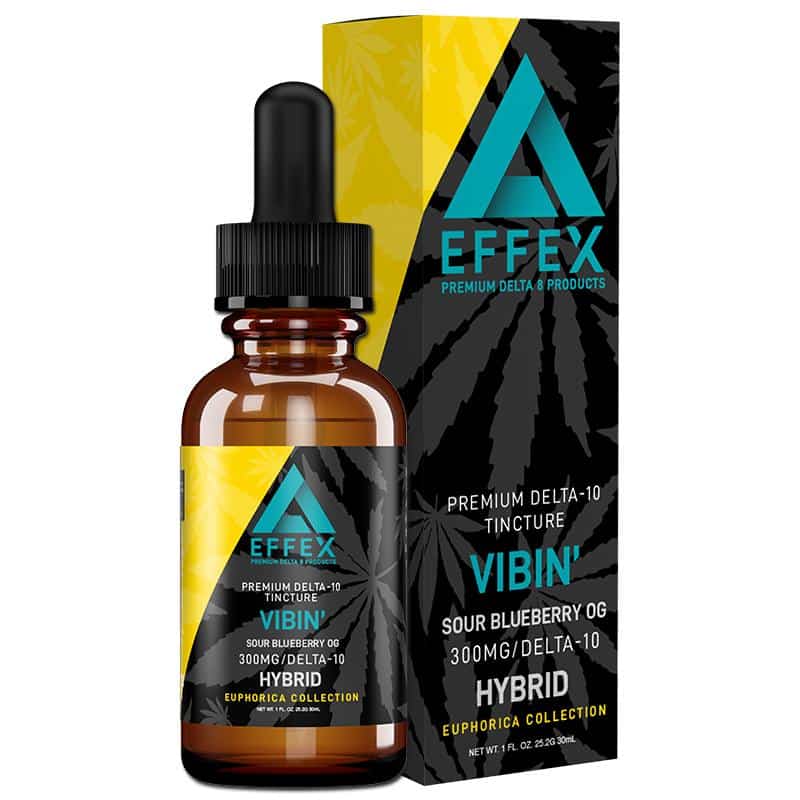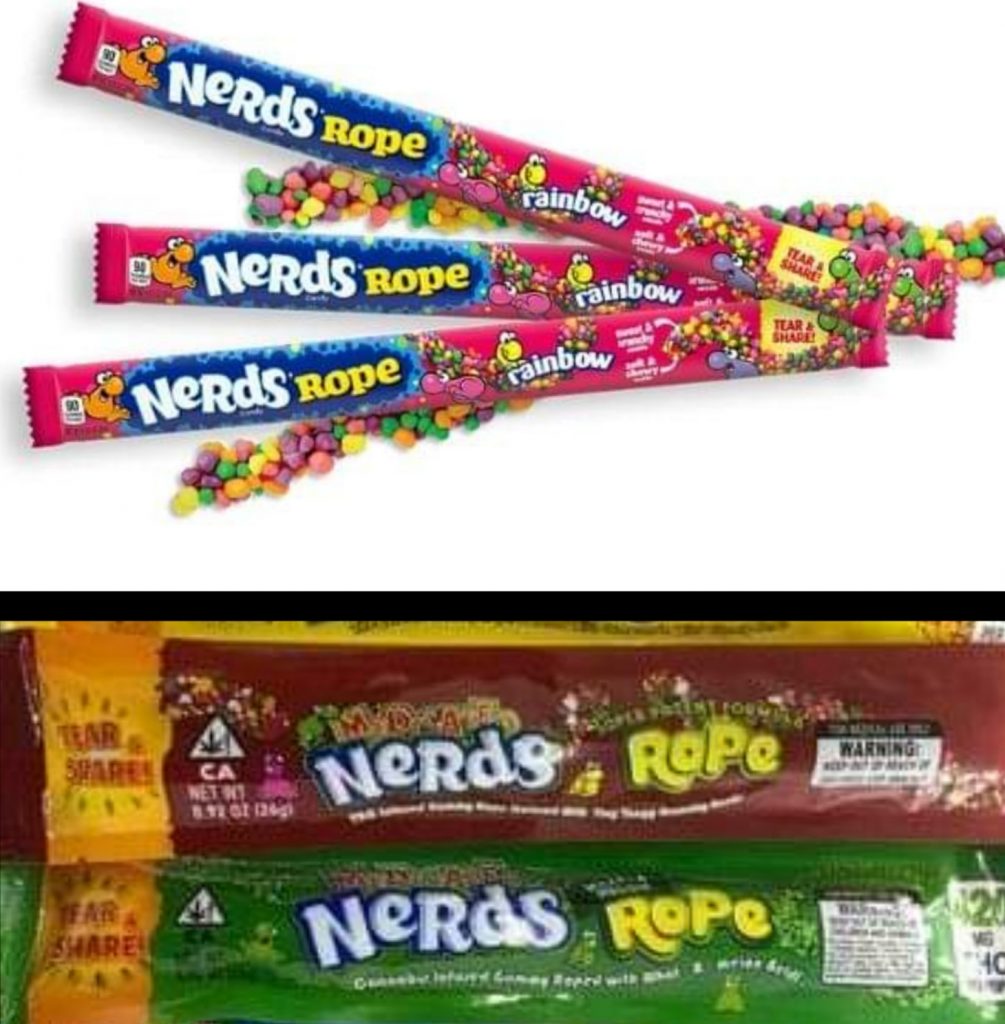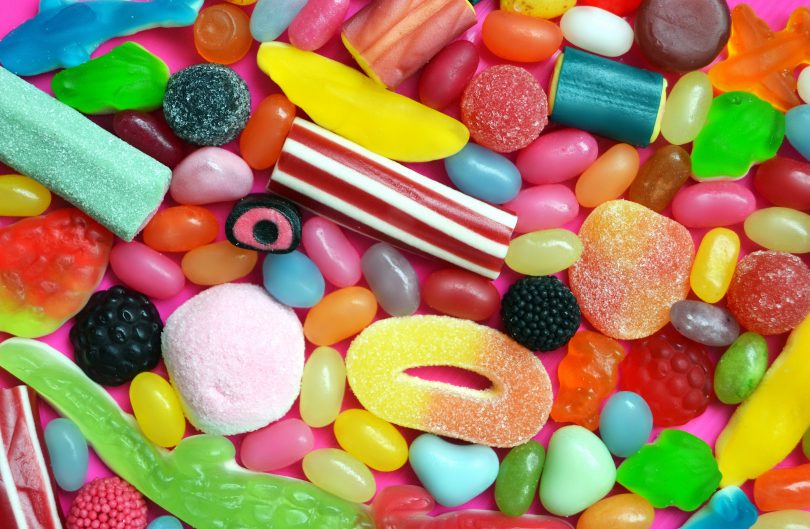Although flower still reigns king in the world of cannabis, edibles are quickly catching pace as one of the most in-demand products on the market today, making up roughly 23% of total sales in 2020. This statistic holds true in both legal and illegal areas. As a matter of fact, in my own experience I have found that edibles are even more popular in states with strict cannabis regulations, where variety and more modern products like concentrates are much harder to find.
Edibles are a fun and discreet way to use cannabis, but when the packaging for products that are extremely high in THC begins to closely resemble that of store-brand candies, to the point that adults AND children are mistaking them on a regular basis, then we have a serious problem. Not only is it a concerning safety issue, but what about trademark violations? A number of big-name candy producers, like Wrigley and Hershey, are suing cannabis companies over these look-alike treats.
NEW: DELTA 10 THC

Food is the best, and there are a million interesting edibles on the market for cannabis! Whether you like your edibles sweet, or salty, there’s something for everyone. Some are higher in CBD, some in THC, and some are made with delta-8 THC, the alternate form of THC on the market, which produces slightly less psychoactive effect, and a more energetic, clear-headed high. No matter how you like to consume cannabis, there are plenty of options, and that goes for delta-8 as well. If you have yet to try D8, check out our awesome Delta 10 THC and Delta-8 THC deals, and pick up a new kind of cannabis product. Subscribe below for exclusive deals!
“Deeply Disturbed”
The fight against consumer cannabis products has found an unlikely proponent in the candy industry. Despite being condemned by wellness advocates as a leading cause of diabetes and heart disease, a growing number of household brands like Mars Inc., Wrigley Jr. Company, Hershey, Mondelez International, and Ferrara Candy Company are suing to protect their brands – as well as our children, they argue.
The lawsuit was file in May against a handful of companies that are selling high-THC edibles packaged to look like Skittles, Starbursts, Reese’s Peanut Butter Cups, Nerds Ropes, Lifesavers, and the list goes on. Although the bulk of the lawsuit is centered around intellectual property rights, there is also mention of the growing number of people, especially children, who are accidentally consuming these products believing they are regular candies.
A spokeswoman for Mars Inc. mentioned that the company is “deeply disturbed” by these products what is going on.

According to recent data from Poison Control Centers around the country, this is a growing trend. For example, in Washington state there were 122 cases of THC exposure in children under 5 within the first 9 months of 2020. In Colorado, 163 calls of this nature were made to poison control. During the course of the lawsuit, brands like Stoner Patch Dummies, the Worlds Dankest Gushers, Gasheads Xtremes Sourfuls, Trips Ahoy, Buttafingazzz and Caribo Happy Cola were discovered.
“The situation has become more and more egregious,” said Christopher Gindlesperger, a spokesman for the National Confectioners Association, a trade organization in D.C. with 350 members, including Mars Inc., Hershey’s, Ferrara and Mondelez. “The cannabis companies cannot and should not be allowed to tarnish existing brands at will. It creates consumer confusion.”
These lawsuits are not the first and certainly will not be the last. So far, they have all been settled out of court with cannabis companies agreeing to change their packaging or completely stopping the production and sale of these products altogether.
Complete Discretion
Cannabis edibles are popular for a few different reasons, but one thing in particular I have noticed is that there doesn’t seem to be the same stigma attached to consuming edibles as there is with actually smoking weed, quite possibly because of how discreet they are. Years ago, the best you could find was some brownies and cookies with a rather unrefined flavor, meaning that you could always taste the cannabis in them because they were often made with whole plant matter.
Now that you can find a huge variety of luxury food items infused with extracted cannabis compounds, it is much easier to equate consuming edibles with drinking fine wine; whereas smoking weed still has a reputation for being the preferred consumption method for the less progressive (old-fashioned) stoners among us. Edibles, vapes, concentrates, and other newer market products often have higher levels of cannabinoids and terpenes and less harmful contaminants than what you would find on the street.
In that same vein, the high-end packaging and sheer variation of infused food products that you can find only adds to the discretion of consuming cannabis this way. It’s much more simple to medicate when you can pull out some fancy chocolates, beef jerky, chips, or sandwich spreads that are rich in cannabinoids. You can travel with them and utilize nearly anywhere.

“Edibles are easy. They’re portable. You don’t have to find a space to step aside and smoke,” said Sean Arnold, a founder of Terradigm Consulting, a company that advises cannabis companies on licensing, infrastructure and product development.
“The accessibility of edibles and the discretion they afford has made them the fastest-growing category in cannabis,” according to Surfside, a cannabis data-analytics company in New York. Surfside estimates that during the last three months, edibles have outpaced the growth of the rest of the cannabis market by 29 percent.
One of the downsides to all this discretion is who can take advantage of it. A couple decades ago, if a teen wanted to get stoned, they had to find a place where no one could see them, hear them, OR smell their marijuana smoke – the latter being quite challenging at times… especially if you’re smoking some fire. It’s so much easier for an adolescent to get by with some infused candies that are packaged to look like all the major brands as opposed to fumbling around with a joint, bowl, blunt, or other type of smokable. This of course brings into question the safety and accessibility of edibles for teens and younger children, which seems to have been overlooked from the start.
No Regulations in Some Markets
Mr. Wykowski said that “transgressions that may have escaped the notice of large corporations like Mars or Hershey’s in the past are on their radar today because cannabis is big business now.” He teaches a course on cannabis law at University of California’s Hastings College of the Law, and one of the topics focuses on how to navigate laws surrounding look-alike products.
“Five or 10 years ago when cannabis was starting to take off, it was a joke to have something like Cap’n Punch, a cereal that’s infused,” Mr. Wykowski said. “But the industry has matured, and the people who know what they’re doing no longer engage in that kind of conduct.”

But again, all these regulations only apply to legal markets. In states where cannabis is still illegal, there’s absolutely no way to monitor the products that are reaching consumers. Sometimes there will be some obvious indicators like using the word “kandy” instead of candy, or little pot leaves placed indiscriminately on the packaging, however, these cues are only obvious to adults. A child would absolutely overlook all these differentiators and, if the packaging is easy to get into, they will definitely eat those products.
This is also a burden for the legitimate candy makers, whose brands can easily be tarnished by people not wanting to have anything could be misconstrued with cannabis edibles in their homes. According to New York-based trademark and brand attorney Nancy J. Mertzel, copywrite laws are in place to protect three main aspects of a candy – appearance, name, and packaging.
“Take Hershey’s Kisses, for example,” says Ms. Mertzel. “You have the name Kisses, which is a trademark, the shape of the candy itself, which is both a trademark and trade dress, and the packaging, which is protected by copyright.” Ms. Mertzel is representing Wrigley brand in the suit. “I certainly understand Wrigley’s concerns about having its intellectual property used by a third party, and those concerns are exacerbated when it’s for a product that children really shouldn’t be getting,” Ms. Mertzel added.
Child-Proofing Cannabis
For most people, keeping intoxicating substances out of children’s hands is the primary concern when it comes to regulating cannabis edibles. According to Andrew Brisbo, the executive director of the Marijuana Regulatory Agency in Michigan, “When we look at accidental consumption, edibles are a primary issue, a young person won’t accidentally smoke a marijuana cigarette.”
When people get too intoxicated on cannabis edibles, it can usually be narrowed down to one of two reasons: overconsumption or accidental consumption (or a combination of the two). Overconsumption can happen because of the slow onset of effects felt from edibles. They can take up to one hour to kick in, and some people either aren’t aware of this or they become impatient, they eat more, and then get hit with way more of a high than they expected.
“Accidental consumption can affect anyone,” says Dr. Gillian Schauer, a public health and policy consultant who specializes in cannabis legislation. “But it has primarily impacted children because they can confuse cannabis edible products with other edible products, because most edibles look like candy or cookies or cake.”
I have personally seen numerous products that look almost exactly like store-bought candies. To the untrained eye of a child (or even to the unobservant eye of an adult), it would be impossible to notice a difference. Edibles often have much higher concentrations of THC than flower, and marijuana ingested via the digestive tract can have stronger and prolonged effects. To make matters worse, children face complications because of their size and weight. Many young children who consume marijuana edibles require hospital admission due to the severity of their symptoms.
Final Thoughts
There are two main takeaways here as far as what the candy company claims to be fighting against. First and foremost, protecting their brands and their pockets. If people are scared to keep candy products in the house for fear of them being mixed up with cannabis edibles, then the big brands start losing money. Number two, to make these lawsuits more memorable and more apt to hold up in court, they are piggy backing of the poison control statistics that indicate children have a higher likelihood of being accidentally exposed to cannabis via edible products. Let’s be honest here, candy companies don’t care about our children’s health and well-being; if they did, they wouldn’t be promoting these chemical products filled with preservatives, dyes, and corn syrup. They care about their bottom line, so any cannabis businesses selling look-alike edible products need to be on high alert.
Thank you for stopping by CBDtesters.co, your #1 spot for the best cannabis-related news globally. Give the site a read-thru daily to stay on top of the exciting world of legal marijuana, and sign up to receive our newsletter, so you never miss a thing. News and deals in your inbox every week!







